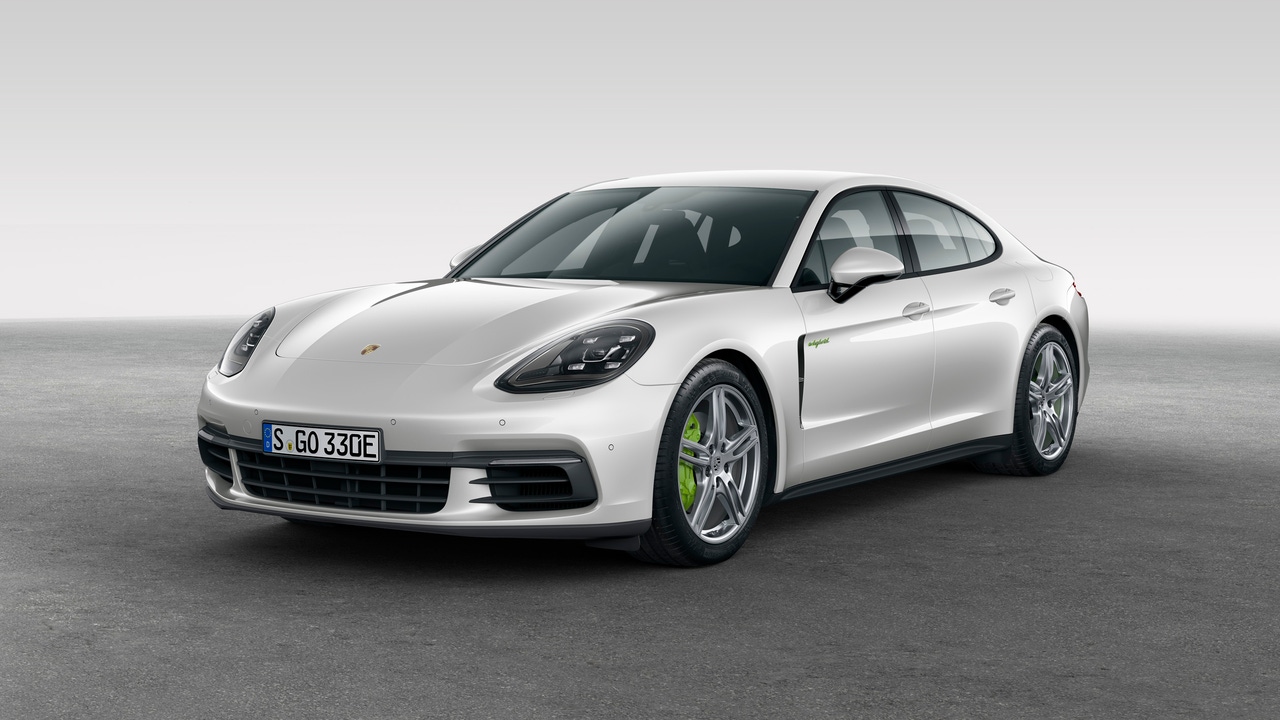Porsche Unveils 173-MPH Panamera 4 E-Hybrid
At the heart of the latest top-line model is a newly developed gasoline-electric drivetrain that combines Porsche’s recently unveiled twin-turbocharged 2.9L V-6 and electric motor capable of a combined 456-hp.

STUTTGART, Germany – Porsche is wasting little time building upon its initial 3-model-strong second-generation Panamera lineup.
Just two months after unveiling the 4S, 4S Diesel and Turbo, the German automaker reveals the 4 E-Hybrid – the fourth and most technically advanced of the new ʼ17-model Panameras to date.
One of two gasoline-electric hybrid models planned to join the Panamera lineup, the plush new 456-hp all-wheel-drive Panamera 4 E-Hybrid is set to make its public premiere at the Paris auto show later this month, prior to the start of North American deliveries in 2017.
The plug-in model succeeds the earlier S E-Hybrid with a 31-mile (50-km) electric range, official 0-62 mph (100 km/h) time of 4.6 seconds and 173 mph (278 km/h) top speed.
At the heart of the Panamera 4 E-Hybrid is a newly developed gasoline-electric drivetrain also set to appear in next year’s Cayenne E-Hybrid. It uses Porsche’s recently unveiled twin-turbocharged 2.9L V-6 tuned to 325 hp and 332 lb.-ft. (443 Nm) of torque in combination with an electric motor mounted in front of the gearbox capable of delivering up to 134 hp and 295 lb.-ft. (400 Nm) of torque.
Together, the system is rated at 456 hp and 516 lb.-ft. (699 Nm), providing the Panamera 4 E-Hybrid with 46 hp and 81 lb.-ft. (109 Nm) more than the first-generation Panamera S E-Hybrid it replaces.
It also is 22 hp and 111 lb.-ft. (150 Nm) of torque up on the second-generation Panamera 4S, powered by a more heavily tuned version of Porsche’s twin-turbocharged 2.9L V-6, albeit without the assistance of an electric motor.
Significantly, Porsche has altered the programming of the electric motor to provide greater emphasis on performance. It now kicks in the moment the throttle is depressed. Previously, the throttle needed to be 80% engaged before the reserves of the electric motor were combined with those of the combustion engine in an earlier strategy aimed at optimizing fuel economy.
The automaker says the new programming is similar to that used for the 918 Spyder. It allows the driver to call up additional power from the electric motor at all times.
The result is a 0.9 second reduction in the 0-62 mph time along with a 5 mph (8 km/h) increase in top speed over the superseded Panamera S E-Hybrid. The official fuel economy figure of 94.1 e-mpg (2.5 L/100 km) on the European test cycle also makes it more economical than its predecessor.
As on other second-generation Panamera models revealed to date, drive is channeled through a new 8-speed dual-clutch gearbox and multi-plate clutch AWD system. The earlier Panamera S E-Hybrid used an 8-speed automatic equipped with a torque converter.
Altogether, there are six different driving modes. They include the Sport and Sport Plus modes of other new Panamera models equipped with the Sport Chrono package, along with the E-Hybrid specific modes of E-power, Hybrid Auto, E-Hold and E-Charge.
As with its predecessor, Porsche’s latest hybrid model is programmed to start in E-power mode. With a fully charged battery, it is claimed to provide a pure electric range of up to 31 miles at speeds limited to 87 mph (140 km/h).
Power for the Panamera E-Hybrid’s electric motor is provided by a liquid-cooled lithium-ion battery. Despite boasting a 4.7 kWh increase in energy storage at 14.1 kWh, it is claimed to weigh no more than the unit used by the older Panamera S E-Hybrid.
Porsche says the battery can be charged in 5.8 hours using a standard 3.6-kW charger, while an optional 7.2-kW charger is claimed to reduce the charging time to 3.6 hours. Charging can be started via the Porsche Communication Management infotainment system or remotely via the Porsche Car Connect app. An auxiliary air conditioner also now allows the cabin to be cooled during charging.
A power meter allows the driver to keep tabs on the operation of the hybrid driveline via a standard 12.3-in. (31-cm) touchscreen display. Similar to that found on the 918 Spyder, it provides detailed data on available energy, including the amount of electricity being used in real time as well as that recovered through brake recuperation. There also is a boost assistant that displays the energy available for boosting performance via the electric motor, as well as a hybrid assistant that provides information on how to regulate the electric drive for maximum economy.
The Panamera 4 E-Hybrid rides on a standard air suspension. The newly developed underpinnings use a 3-chamber design in combination with electronic damper control and dynamic chassis control that supports torque vectoring and active roll stabilization.
About the Author
You May Also Like

